When Did the Colombian Revolution Start Which Flag Is Yellow Blue and Red

This page is part of © FOTW Flags Of The World website
Colombia - Historical Flags (pre-1856)
Last modified: 2021-08-26 by  klaus-michael schneider
klaus-michael schneider
Keywords: colombia | new granada | miranda | cauca | vargas | cundinamarca | cartagena | nueva granada | buga | sun | moon |
Links: FOTW homepage | search | disclaimer and copyright | write us | mirrors
- Overview
- Flags According to Steenbergen Book
- Historical Flags Site
- Pre-Independence Coat of Arms
- 1797 Flag
- 1806 Flags
- "Carlos III" Flag
- 1811 Flags
- 1814 Flags
- 1819 Flag
- 1821 Flag
- 1834 Flags
- Colombia - Historical Flags (1856-1909)
- Colombia - Historical Flags (1910-1949)
See also:
- Colombia
- Cartagena State (1811-1814)
- Cundinamarca Independent State (1813-1814)
- United Provinces on New Granada (1814)
- Irish Legion in the Neogranadine Army - XIXth Century
- Great Colombia Federate Republic (1819-1830)
- New Granada Republic (1831-1856)
- Grenadine Confederation (1856-1861)
- United States of New Granada (1861)
- United States of Colombia (1861-1886)
Other sites:
- Presidencia Site - Historical Flags
Overview
Professor Restrepo Uribe told me that between 1834 and 1861 the nine provinces of Colombia used flags of their own: the national flag with the provincial shield in the center.
But during the same time Colombia changed its flag two or three times (including vertical stripes version).
Jaume Ollé, 8 September 1996
I have searched on the history of the Colombian flag. After final independence was achieved in 1819, the Great Colombia used a tricolor flag, yellow- blue-red, horizontally arranged, at a 3:2:1 ratio -that is to say, yellow was larger than blue and blue was larger than red-. After the Federation dissoluted in 1830, Colombia kept using that flag until 1834. In 1834, the country's name became "República de Nueva Granada", and the flag was changed: the stripes were vertical, all of the same width, and the order, from hoist to fly, was red-blue- yellow. This flag was then changed on November 26, 1861, to the present flag, with horizontal stripes, yellow-blue-red, at a 2:1:1 ratio.
My source is "Banderas y Escudos del Mundo EASA", Editorial América S.A., 1986., as well as personal experience
Jaime Vengoechea, 10 April 1999
Before 1834, the shade of blue in Colombian flags was celeste (light blue) and not the same shade of the current national flag.
Jaume Ollé, 26 October 2001
Since independence in 1812, there has been 14 flag design changes in Colombia and its preceding federal states. This includes the restoration of the Spanish ensign from December 1815 to August 1819.
Ralph Kelly, 13 August 2005
The New Granada became turned into the Viceroyalty of New Granada, which existed in the following periods of time 1717-1723; 1739-1810 (flag and CoA) and 1816-1819.
The "gap" between 1723 and 1739, the Viceroyalty of New Granada was again part of the Viceroyalty of Perú .
The "gap" between 1810 and 1816 the Viceroyalty of New Granada was a series of independent Provinces (see this and this sections) which emerged as an independent country as a whole as the United Provinces on New Granada in 1814. In 1810 is considered the date Colombia gained its independence from Spain, although several Civil Wars ensued, thus being called "La Patria Boba" (The Dumb Fatherland"), due to conflicts as to where to adopt either a Centralist government (Cundinamarca since 1813 and its allies, ) or a Federalist government (the United Provinces since 1811). The Spaniards launched an invasion in 1814, dubbed the "Expedición pacificadora" (Pacifying expedition), reocuppying in 1816 the territories that sparked rebellion back in 1810. For the full timeline check: http://es.wikipedia.org/wiki/Nueva_Granada
Sources:
http://en.wikipedia.org/wiki/History_of_Bogot%C3%A1#Government_and_administration
http://es.wikipedia.org/wiki/Real_Audiencia_de_Santa_Fe_de_Bogot%C3%A1
http://es.wikipedia.org/wiki/Provincias_Unidas_de_la_Nueva_Granada
http://es.wikipedia.org/wiki/Virreinato_de_Nueva_Granada
http://en.wikipedia.org/wiki/Viceroyalty_of_New_Granada
http://es.wikipedia.org/wiki/Nuevo_Reino_de_Granada
http://en.wikipedia.org/wiki/New_Kingdom_of_Granada
http://es.wikipedia.org/wiki/Imperio_espa%C3%B1ol
http://en.wikipedia.org/wiki/Spanish_Empire
Esteban Rivera, 21 April 2010
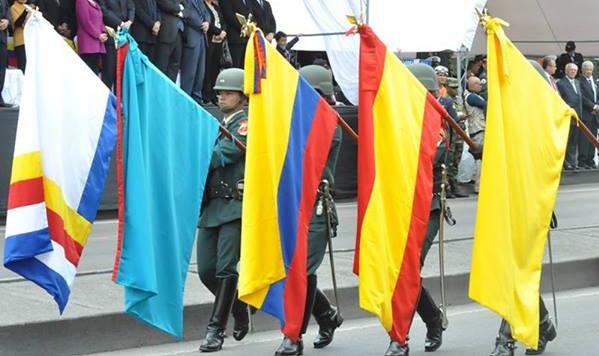
image located by Esteban Rivera, 27 July 2013
During the past Colombian Independence Day military parade (July 20), the reverse of several historical flags can be appreciated in this picture.
Picture found here and a picture gallery found here.
From left to right, the flags (reverse) are:
- 1797 flag
- 1806 flag
- Carlos III flag
- 1811 flags
Esteban Rivera, 27 July 2013
Flags According to Steenbergen Book (1862)
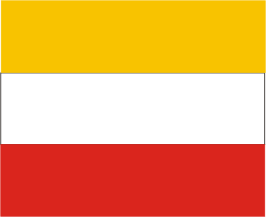
image by Jaume Ollé, 27 September 2003
No. 1014 - Colombia - Obsolete [Probably a mistake since such flag is not reported in any other source].
Source: [stb]
Jaume Ollé, 27 September 2003
The image of the Civil and War Ensign c.1520-c.1701 (Spain) is most likely the flag that was meant to appear instead of this one above (No. 1014).
My remarks are that even though the Cruz de Borgoña o Aspa de Borgoña (Burgundy Cross) was the flag officially in use from 1506 (other sources claim it was being used as early as 1492 ) its use lasted until 1785 (other sources claim as late as 1898), the Ensign on ships could posibly be the one featured on FOTW here.
Esteban Rivera, 21 April 2010
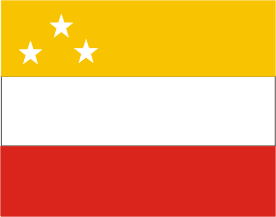
image by Jaume Ollé, 5 October 2003
No. 1040 - Colombia - Obsolete [Unknown to me. I believe that the central stripe must be light blue].
Source: [stb].
Jaume Ollé, 5 October 2003
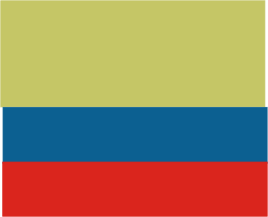
image by Jaume Ollé, 26 October 2003
No. 1114 - Colombia - Obsolete [Obsolete and wrong, the green must be yellow, the blue lighter].
Source: [stb].
Jaume Ollé, 26 October 2003
Historical Flags Site
Almost a year ago, Dov Gutterman found in the web of the colombian presidency a page with a short synopsis of the colombian flag history at <www.presidencia.gov.co> and it contains 16 flags with a short explanation of each one of them. I had drawn most of those flags .Here is also a translation of the info at that page. My comments are between brackets.
Jorge Candeias, 1 October 1999
Pre-Independence Coat of Arms
prein.gif)
image by Jaume Olle, 15 September 2001
Until 1810 only spanish flags were used in Nueva Granada. But the so-called Kingdom of New Grenada had arms granted by King of Castilla and Catalonia, Charles V, in Royal Cedule issued 3 December 1548. (A lot of cities also obtained arms)
Jaume Olle, 15 September 2001
The Audiencia y Cancillería Real de Santa Fe de Bogotá, commonly known as Real Audiencia de Santa Fe de Bogotá, was the highest tribunal of the Spanish Crown (http://es.wikipedia.org/wiki/Imperio_espa%C3%B1ol ) in the new discovered and colonized territory of New Granada (es_colon.html#for). It was based in Santa Fe de Bogotá ( co-dc.html ). It was established in 1549 with the following hierarchy (in the beggining): City Mayor and the Chapter formed by two Council men assisted by the Constable and the Police Chief which governed the city. For better administering these domains in April 1550 the Audience of Santafé de Bogotá was organized, for Oidores (Hearers) to act. From that time the city became the capital and the home of New Kingdom of Granada (1550-1717) (flag: es_brgdy.html#yel, es1701.html#siz and CoA: co-hist.html#pre) government. Fourteen years later in 1564, the Spanish Crown designated the first
Royal Audience Presidente (Chairman), Andrés Díaz Venero de Leyva. Until the constitution of the Viceroyalty of the New Granada, its territory was under the administrative jurisdiction of the Viceroyalty
of Peru.
The CoA of the Royal Audience is seen here: http://www.mincultura.gov.co/bicentenario/wp-content/uploads/2010/02/26.jpg (image taken from the Ministry of Culture of Colombia, official website). The CoA of the Royal Audience is based on the Royal Standard of Phillip II (es_r1580.html) who was King of Spain (between 16 January 1556 - 13 September 1598). Source: http://es.wikipedia.org/wiki/Anexo:Banderas_espa%C3%B1olas (image here: http://es.wikipedia.org/wiki/Archivo:Estandarte_Real_de_Felipe_II.svg )
The flag of the Royal Audience is most likely the Royal Standard of the Catholic Kings 1492-1506 ( es_15thc.html#roy), since the CoA of the Royal Audience ( http://www.mincultura.gov.co/bicentenario/wp-content/uploads/2010/02/26.jpg ) has the same Arms as the Royal Standard of the Catholic Kings.
Esteban Rivera, 21 April 2010
1797 Flag
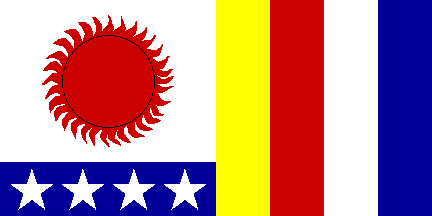
image by Jorge Candeias, 1 October 1999
From <www.presidencia.gov.co>: "Designed by Francisco Mirando [isn't it Miranda?, JC] in 1797, referring to the social classes and to the four fundamental aims the patriots aspired to: equality, liberty, property and safety. " [this is the tetracolour flag also used today as the state flag of Vargas, Venezuela. It can be described like this: Divided vertically into two equal fields. The hoist field is white with a blue horizontal stripe 1/4 height along the bottom. The white part is charged by a red sun; the blue stripe is charged with 4 white 5-pointed stars. The fly half is divided into 4 vertical stripes, yellow, red, white, blue. The overall proportions look like 1:2].
Jorge Candeias, 1 October 1999
Editorial note: According to other source, this reported flag is wrong and the right flag is the flag that is used today by Vargas state, Venezuela, as described there.
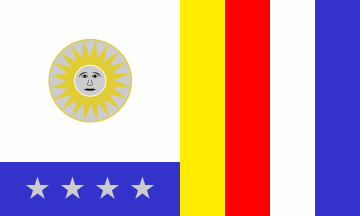
image by Eugene Ipavec, 2 January 2008
Colombia and Venezuela use to be one single country in the beggining. As such they have many symbols in common. One of them is the 1797 flag shown here. It was the same symbol used by both countries and then, only one country, Virreinato de Nueva Granada, or ViceRoyalty of New Grenada.
The image is based on a photo taken on Colombian Independence Day, July 20, 2006 in Bogota.
E.R., 2 January 2008
1806 Flags
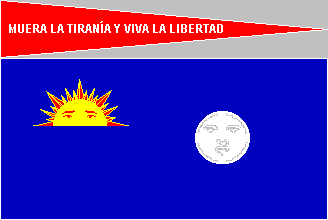
image by Guillermo Aveledo , 7 September 1999
From <www.presidencia.gov.co>: "This was the emblem of the brigantine Leandro when it was put in the water at 12 March 1806. This flag was the symbol of victory "- [blue with a full moon centered and a raising sun in the canton. A long and narrow red streamer flies above the flag with no identifiable writing. In the original file there seems to be something in lower hoist and details are very difficult to resolve. The overall proportions seem to be about 2:3, excluding the streamer.]
Jorge Candeias, 1 October 1999
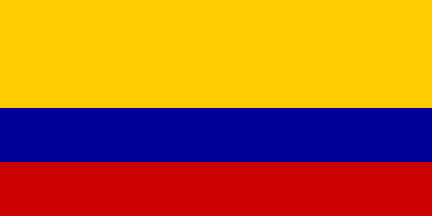
image by Jorge Candeias, 1 October 1999
From <www.presidencia.gov.co>: "At 12 March 1806, our national tricolour was flown for the first time. Miranda was inspired by the predominant colours of the rainbow [?] and it was flown on land in the port of La Vela in August of the same year" [It is the colombian yellow-blue-red horizontal in 2:1:1. Judging by that drawing, it was 1:2].
Jorge Candeias, 1 October 1999
About the red flag loaded with a white rhombus and simultaneously this one with a blue rectangle, I must comment that I don't know it with that exact description, nevertheless, several sources speak of a similar flag that only difference in which the blue rectangle, is not blue nor green (like the Italian of 1802-1805) but is black. About this flag Luis A. Bohórquez says: "On July 15th, Bolivar decreed on Trujillo (Venezuela) the War until Death to the Spaniards and created the respective flag". If I don't interpret badly, Bohórquez attributes to Bolivar the creation of this flag, fact that contradicts what it has been argued in this forum about the paper of Bolivar as flag designer. Then, we remember that Bolivar visited Italy on 1805, time of the Italian flag similar to the one of our exposition, and that he was present the Napoleon' coronation and did there his very well known oath on Monte Sacro. Would be inspired Bolivar on the Italian flag of that time when he decreed War until Death to the Spaniards?
Given the facts, it could well have happened this way. Perhaps, he wanted to offer a tribute to Italy when he arrived to Trujillo, then could think that he had fulfilled his oath. By another part, is also says that admiral Padilla used the flag of the white rhombus.
Eduardo Garcia Perdomo, 13 July 2005
"Carlos III" Flag
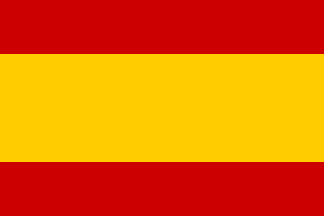
image by Jorge Candeias, 1 October 1999
From <www.presidencia.gov.co>: "Red and gold of Carlos III. It's colours symbolize the military notion in the orders of his majesty for the regime, discipline, subbordination and services of his armies, effective since the time of D. Carlos III ".[This is the spanish triband. I'm not sure I understood the original text, so this translation may contain errors. Anyway, this image should, I suppose, contain the arms of Spain from that period, as depicted in the Spanish pages. Proportions, 2:3].
Jorge Candeias, 1 October 1999
1811 Flags

image by Jorge Candeias, 1 October 1999
From <www.presidencia.gov.co>: "In 1811 the predecessor [?! I suppose they refer to Miranda] leaded the mantuans [?!] under a big yellow banner, used by the armies in the Liberating Campaign of 1819" [A plain yellow flag with 2:3 proportions].
Jorge Candeias, 1 October 1999
Confederate Cities in the Cauca Valley
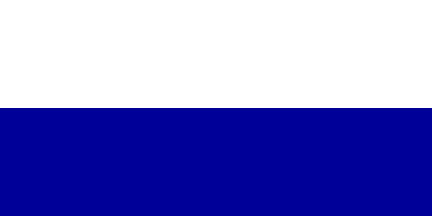
image by Jorge Candeias, 1 October 1999
From <www.presidencia.gov.co>: "This flag was adopted by the confederate cities in the Cauca Valley, approved at 26 July 1811. The General Jose' Maria Cabal took part in the delegation and his troops took the flag in campaigns along the Palace' [this is a white over blue horizontal bicolour, unlike the current flag of Cauca." [Again, I'm not certain of my translation. The text is quite confusing . Anyway, the proportions seem longer than 2:3. I made it 1:2, perhaps exaggerating].
Jorge Candeias, 1 October 1999
Cauca Valley has a complicate history. First autonomist movements started in July 1810. In August some cities created a confederation for defense from the royalist that controlled mainly Popayan and Pasto. More cities adhered to the Confederation in September 1810. On October, Cali claimed that the confederation would be recognized as separate province (separate from Popayan). The flag - celest over white, was used as cockarde, flag and band. On 5 February 1811 the confederation didn't recognize the spanish regency government anyomore. Popayan (royalist) was conquered on 1-4-1811 but royalist remained in Pasto. On 21 June 1811 junta of Confederate cities established in Popayan and flag was adopted on 26 June 1811. It was celest over white and fringed argent in at least three sides. It was used as band, flag and coackarde. Confederation lost and reconquist Popayan for several times (even conquered Pasto for some time), and first obtained help from the United Provinces and after 1813 (with a previous small help in 1811) from Cundinamarca. The dictatorship of Cundinamarca, Nari?o, was capturated by royalist in this war, when leading cundinamarquese troops in help of the confederates. At the end royalist defeated the independentist and in 1816 the confederation ended and spanish rule restablished as was in rest of provinces except Casanare, where the independentist resistence, led by Santander, and helped soon by Venezuela, started to recover the country.
Jaume Ollé, 15 September 2001

image by Eugene Ipavec, 6 january 2008
The flag featured as the CIudades Confederadas has the blue color wrong. It must have the same shade of blue as the Department of Valle flag and in the same description, celestial (light) blue over white.
E.R., 4 January 2004
Cundinamarca Regiments Flag
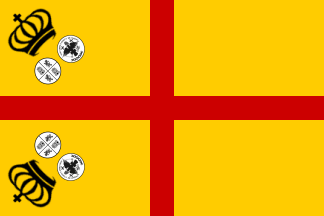
obverse
image by Eugene Ipavec and Jorge Candeias, 30 May 2006
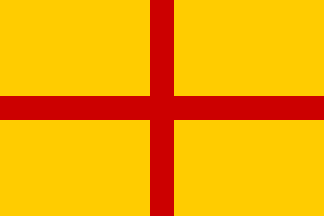
reverse
image by Jorge Candeias, 30 May 2006
From <www.presidencia.gov.co>: "From the regiments of Cundinamarca of 1811 the government decreed that the flag should be yellow with a red cross and it it's corners the shields of Cundinamarca, Castille and Leon. It was held by Narin~o in all his campaigns." [my image is just a sketch, since it is impossible from the original file to know where should be placed each of the shields. Anyway, they are in the hoist quadrants (more specific than "corners"). The source shows a long flag, so I made it 1:2].
Jorge Candeias, 1 October 1999
In a recent Military parade held in Bogota this year to commemorate Colombia's Independence Day (July 20), all the historical Colombian flags were flown. According to my sources (a booklet from the Military Museum in Bogota and also the pictures taken from the TV broadcast that day), the flag (ratio 2:3) should be called Bandera de los Regimientos de Cundinamarca (Cundinamarca Regiments flag). The obverse of the flag should be yellow background and the red stripes (one vertical and one horizontal), just like it is shown here and on the top left corner clockwise there is the Crown of Spain, the arms of the State of Cundinamarca and the arms of Castilla and León encircled. On the bottom left corner the same composition. From what I saw on the pictures, all of the Coats of Arms depited on this flag are outlined (in black and white).
This flag was carried by Colombian General Anotnio Nariño in all his campaigns against the Spaniards.
The reverse of the flag is the yellow background and the red stripes (one vertical and one horizontal).
At that time Colombia was divided among Centralists (State of Cundinamarca and its allies) and the Federalists (Provincias Unidas de Nueva Granada), two rival government entities that even fought a civil war. This period is known as "La Patria Boba" (The dumb fatherland) because due to the internal conflict it was rather easy for Spain to reconquer in 1816 the territory that had declared independence on July 20, 1810.
E.R., 6 March 2006 and 30 May 2006
Cartagena
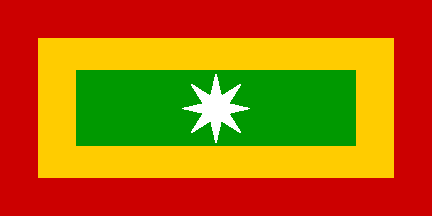
image by Jorge Candeias, 1 October 1999
From <www.presidencia.gov.co>: "Flag of Cartagena. At 17 November 1811, it [the flag, I presume] received an oath of loyalty from the troops gathered there. Bolivar took it in the Admirable Campaign in 1813, using it Atanasio Girardot did the feat of the _Barbula_. It was adopted as emblem in April 1814 by the Congress of the united provinces of Nueva Granada" [The flag is green (?) with a yellow inner border and a red outer border and a white 8-pointed star centered. The green is highly dubious. The colour of the original is not clear, but is distinctly greenish. I suspect, however, that it should be blue instead, as in all other colombian flags I know of. I'm posting the green "version" anyway. Also a long flag in the original drawing, so I made it 1:2, probably exagerating].
Jorge Candeias, 1 October 1999
See also: Cartagena State (1811-1814) and Cundinamarca Independent State (1813-1814)
1814 Flags
From <www.presidencia.gov.co>: "Ninth flag - Of an independent Cundinamarca. In the year 1814 was adopted as a symbol of Nueva Granada and ment a second act of conversion of the tricolour. Nation corresponding to the identity of heroic aims and ideals of Nariño, Miranda and Bolivar"[The flag is a tricolour of blue, yellow and red, with equal horizontal stripes and with an oval centered charged with what looks like an eagle.
Jorge Candeias, 1 October 1999
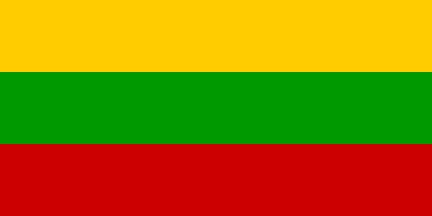
image by Jorge Candeias, 1 October 1999
From <www.presidencia.gov.co>: "At 26 April the Congress gathered in Tunja adopts it as symbol of the united provinces of Nueva Granada. Later it was adopted as banner of the city of Buga. "[this one is a plain horizontal tricolour with equal heights, yellow, green (?), red. Proportions definitely 1:2].
Jorge Candeias, 1 October 1999
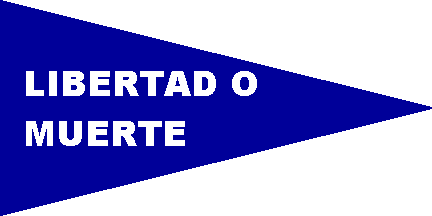
image by Jorge Candeias, 1 October 1999
From <www.presidencia.gov.co>: "Of the Bolivarine lancers. Designed by the liberator Simon Bolivar and carried by his troops during the campaign of War to Death [this is a blue triangular flag with white writing reading "LIBERTAD O MUERTE" (freedom or death)]
Jorge Candeias, 1 October 1999
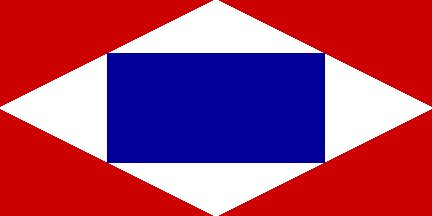
image by Jorge Candeias, 1 October 1999
From <www.presidencia.gov.co>:"This one continues the flag of War to Death and the troops carried it from 1814 upto the battles of the Vargas swamp and Boyaca' bridge that established definitively our independence" [this one is clearly based on napoleonic designs: red with a large white lozenge including a blue rectangle. Another long flag, but again I might have exagerated by making it 1:2].
Jorge Candeias, 1 October 1999
There's a picture of a historic Neogranadine (Colombian) flag of Guerra a Muerte (War to Death) used in 1814. The image of the the Flag is taken from the Ministry of Culture of Colombia, official website, and it is part of a collection of items and artifacts from the time of Colombia's independence from Spain.
Esteban Rivera, 21 April 2010
The information regarding this flag on the National Museum of Colombia says that the measures of this flag are 18,5 x 19,7 cm.
Esteban Rivera, 24 April 2010
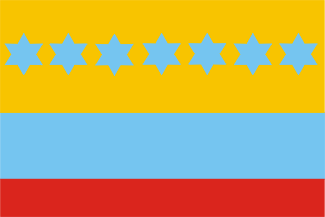
image by Jaume Ollé, 15 September 2001
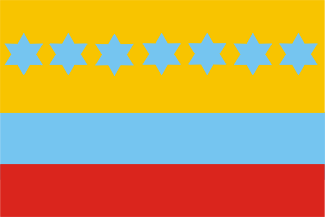
image by Jaume Ollé, 15 September 2001
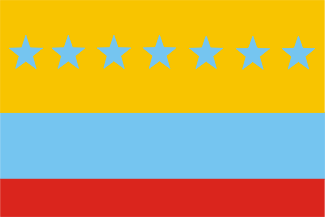
image by Jaume Ollé, 15 September 2001
In 1819 campaign there was mainly using the Miranda flag, that was yellow, blue and red (4:2:1) but also was used the flag of Padilla, a pirate chef that in1813, leading Cartagena military forces, helped Bolivar in the so-called "war at death" against spanish in 1813. The Padilla flag is only reported with date 1819 and is red with white losange containing a black rectangle.Flagmaster picture it with yellow losange, but seems to be another mistake.
Jaume Ollé, 15 September 2001
See also: United Provinces on New Granada (1814)
1819 Flag
See: Great Colombia Federate Republic (1819-1830)
1821 Flag
See: Great Colombia Federate Republic (1819-1830)
1834 Flags
See: New Granada Republic (1831-1856)
Colombia - Historical Flags (1856-1909)
Source: https://www.crwflags.com/fotw/flags/co-hist.html
0 Response to "When Did the Colombian Revolution Start Which Flag Is Yellow Blue and Red"
Postar um comentário